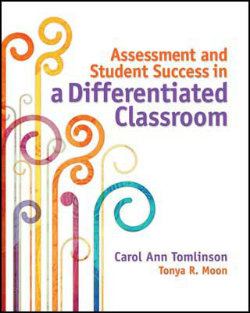Assessment & Success in a Differentiated Classroom
Assessment and Student Success in a Differentiated Classroom
By Carol Ann Tomlinson and Tonya R. Moon
(ASCD, 2013 – Learn more)
Reviewed by Fran Loose
This review is from a special education perspective, and in particular from a higher education perspective in a special education pre-service program.
Assessment and Student Success in a Differentiated Classroom by Carol Ann Tomlinson and Tonya R. Moon is a concise, practical, high quality and clearly articulated analysis of the role of assessment in differentiated classrooms. It would serve as an excellent resource for university teacher pre-service programs as well as for district-level professional learning community (PLC) book study.
T
The authors devote the remainder of the book to a detailed analysis of assessment “how to’s” and “why’s”, designed to serve as “the compass for daily planning in a differentiated classroom.” (p. 8)
- Differentiated Ongoing assessment (formative)
- Differentiated summative assessment (traditional paper-and-pencil, as well as performance-oriented, including performance tasks, constructed responses, and product development)
- Grading considerations in a differentiated classroom
Tomlinson and Moon offer the medical analogy regarding the importance of an accurate diagnosis as the basis for prescriptive planning. They surface sets of probe questions to help the teacher develop a laser focus on the essential elements of the lesson/unit and to design the assessment so that it
- accurately reflects students’ status on the standards (not having performance affected by e.g. vocabulary in directions, required response mode…) and
- informs future instruction. (e.g. p. 78)
Examples and resources across the curriculum
Throughout the book the authors provide definitions, many clear examples, scenarios and graphic organizers of assessment differentiation issues and strategies across the core content areas: English language arts, mathematics, social studies and science. Their examples reflect elementary, middle and high school standards, and they reference common concerns in teaching English language learners and students with IEPs.
For example, the authors offer strategies (p. 74) re: how to prepare for a 6th grade lesson on ratios and percentages when one of the class members is working on the 3rd grade place value concept (ten-thousands place). They consistently assist the reader with thinking through ways to close achievement gaps—to accommodate for the learning difficulties of some learners while simultaneously challenging learners who are advanced in their knowledge, understanding and skills regarding the curriculum standard being addressed.
Helpful insights about assessment
Relative to summative assessment, the authors offer an array of approaches, identifying the strengths and limitations of each, applying three principles to the decision making process.
- Differentiated assessments should focus all students on the same essential learning goals (KUDs), with the exception, again, of students whose individualized education plans indicate alternate goals.
- Students should be assessed in ways that allow them ample opportunity to demonstrate their knowledge, understanding, and skills.
- The scoring system used for evaluating differentiated assessments should be the same regardless of the type of differentiation. (pp. 98-99)
The most thought provoking chapter deals with grading — a major philosophical, measurement and emotional challenge for teachers serving a diverse student population (from a non-reading 15 year old in a 7th grade classroom to advanced students who are not motivated to work hard) .
Clearly, fine tuning effective use of assessment data in differentiated grading is going to be a work in process for most teachers. The approach makes perfect sense yet can be challenging to implement. Tomlinson and Moon provide the necessary guidance to help teachers continuously improve their knowledge, understanding and skill implementation of grading practices that accurately communicate to each student and parent, his/her performance on accepted standards.[1] The authors’ “goal is to increase reliability and validity and to reduce error and teacher bias.” (p.123)
Tomlinson and Moon identify seven principles which guide quality grading practices and support teachers in attaining the goal. They also specifically speak to strategies that address the motivational and emotional concerns of students, teachers and parents. One of their closing comments captures the essence of the chapter:
“The best-case scenario for grades is that they present students and parents with accurate and intelligible representations of development in a context where all efforts are aimed at moving students as far forward as possible from where they begin in a content area by addressing their varied readiness needs, interests, and approaches to learning.” (p.138)
Tomlinson and Moon’s Assessment and Student Success in a Differentiated Classroom is a valuable resource for beginning and veteran teachers, in general and special education, in K-12 and university settings. It’s a book best read once then revisited periodically, ideally as part of a professional learning community’s continuous improvement work.
_____________________
1 The authors also acknowledge that there are different purposes for grading (ranking, motivating/punishing, grouping/sorting, teacher/program evaluation) which would suggest alternative approaches.
Frances Loose has served as a special education teacher, consultant, local and state administrator and university instructor. Most of her experience in school districts focused on students with learning disabilities and supporting their families and teachers. She has a Ph.D. in Special Education Administration from Michigan State University and a BS and MA in special education from the University of Michigan. She has presented on a range of topics and published articles in these areas and instructional texts for students with disabilities.



































